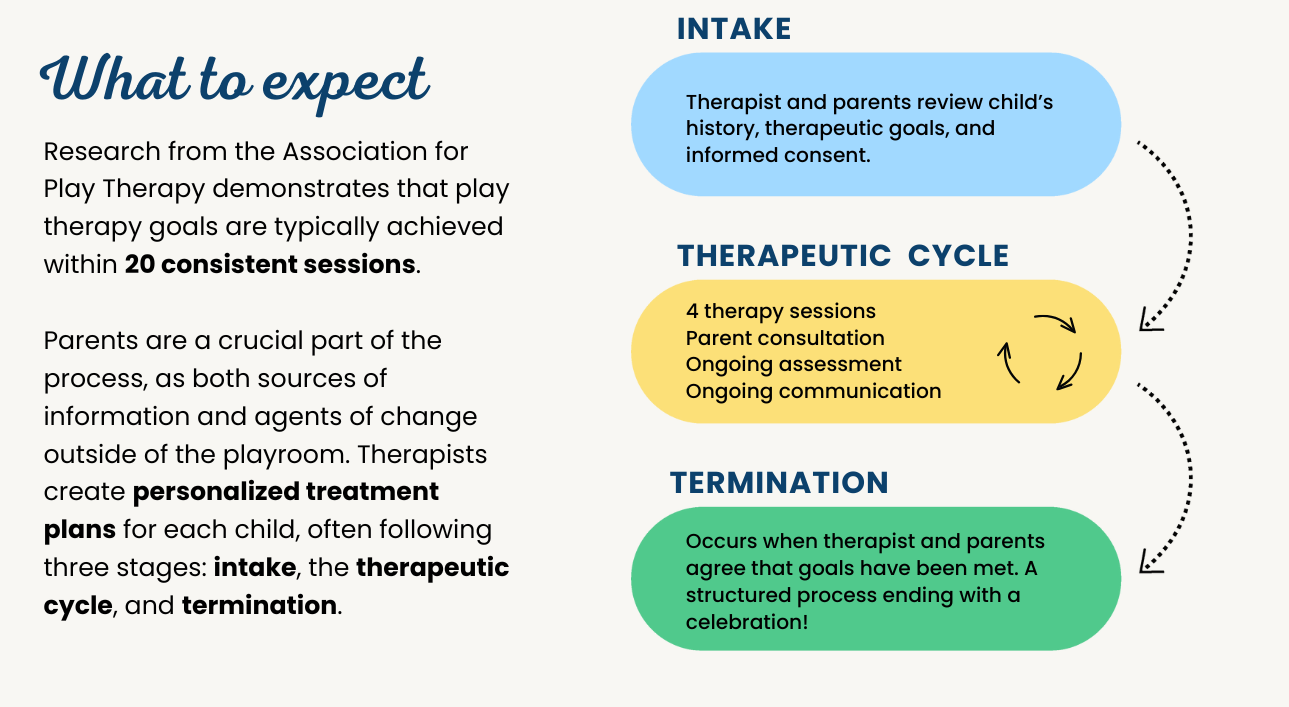What is Play Therapy?
“Play Therapy is based upon the fact that play is the child’s natural medium of self-expression. It is an opportunity which is given to the child to ‘play out’ his feelings and problems just as, in certain types of adult therapy, an individual ‘talks out’ his difficulties.”
– Virginia Axline
Play therapy is the most appropriate form of therapy for children. Children do not yet have the words to fully engage in talk therapy as you may expect an adult to do when they seek therapy. If we look at child development, children develop abstract reasoning around the age of 12. Thus, we wouldn’t expect a young child to see us and talk during the full 45 minute session. In play therapy, your child will play (stating the obvious, we know), however your child’s play will be in the presence of a trained play therapist. At our practice, this means we have specific play therapy training in graduate school and have had additional training opportunities on how to be present and track your child’s play behaviors. We provide various facilitative responses and help children make meaning of their play. We really aim to help children see the need behind their behaviors and better understand their emotions throughout play therapy.
Additionally, in play therapy, your child will be in a play room which has specific categories of toys that allow for exploration of real life experiences. These categories of toys include:
- Real life and nurturing toys (doll house, kitchen set, cash register, medical set, puppets, animal families, and more)
- Aggressive and scary toys (scary/aggressive puppets like sharks and alligators, swords, handcuffs, toy soldiers, bop bag, and more)
- Creative expression and emotional release toys (sand, paints, craft materials, music instruments, dress up clothes, legos, and more)
How Does This All Look in Action?
Many parents often ask how it works or what it looks like in the playroom. Typically, we begin therapy services with every child by first meeting with the child’s guardians. Once your family decides to meet with one of our therapists, we schedule the initial session which lasts about 60 minutes for just the guardians. We use this time to learn more about your child’s history (starting from their very early experiences), and gain a better understanding of how your child may see their world and how they see themselves. We also learn more about family and friend dynamics and any stressors or traumas they have experienced. Finally, we use this time to discuss what the first session with your child will look like and our plan for our next parent session.
The second session is really our first session with your child. In this session, we first greet your child as you walk through the door and share the playroom with your child. We always let them know that in the playroom, they can play with anything they want and we allow them the time and space to explore the room. During this first session, we utilize various verbal responses to show children we are present, attuned, interested, and accepting of their play and behaviors. We use statements to help children become aware of their emotions (for example “you’re super excited to see we have a doll house here”), encourage freedom of expression ( “You are making that just the way you want it”), and even use esteem building statements (“you’re so proud you made the tower so tall”) to help children feel connected and capable (Ray, 2011). Above everything, we focus on building a safe and attuned relationship with your child. We want them to know we accept every part of them, even the parts that may be experiencing sadness, anxiety, anger, frustration, or any other difficult experience. After about the first 3-4 sessions, we will create a treatment plan with goals, objectives, and interventions and share with you during our next parent session.
Throughout our sessions, we believe that it is important to communicate and work with the adults in the child’s life. This includes guardians, teachers, counselors, psychologists, etc. We encourage guardians to meet with the therapist every 4-6 sessions and use this time to share more with you about themes coming up in your child’s play therapy sessions, hear about how things are going at home and school, provide recommendations or skills to try, and provide some helpful information to better understand your child’s behaviors.

How Long Is the Play Therapy Process?
While we love all the children and families we work with, we know that eventually the goal is for your child to graduate out of therapy. During our parent consultations, our goal is to collaborate with you on your child’s goals and assess progress to discuss when an appropriate time to end therapy services may be. This is typically when we see growth and progress in your child and family goals. We may begin by moving to every other week sessions and eventually may even move to once a month sessions. According to research from the Association for Play Therapy (APT), “it takes an average of 20 play therapy sessions to resolve the problems of the typical child referred for treatment.” We want to emphasize that this process is unique for each child and we aim to be fully transparent and communicative with you every step of the way.


